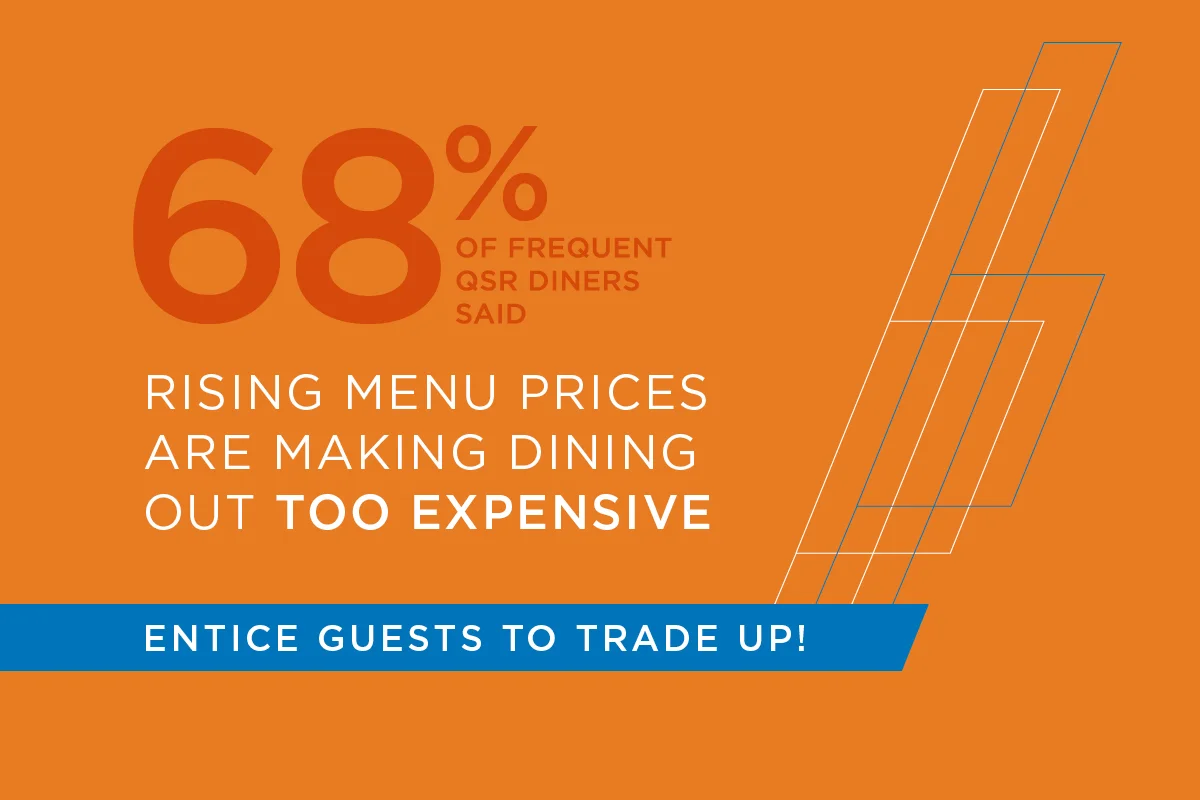Summary
- Record-high inflation threatens to depress restaurant demand.
- Well-timed incentive marketing campaigns can inspire action with guests concerned about finances.
2021 was the year of the comeback for restaurants. Consumer spending at restaurants increased by 16%, compared to 2020, when it fell by 12%. However, 2022 is a different story. With inflation at a 40-year high, and driving costs up, businesses and consumers are feeling the pinch.
According to the U.S. Bureau of Labor Statistics (BLS), the index for food away from home increased by 6.9% over the last year, the highest 12-month increase since December 1981. The total price of restaurant receipts in 2021 was up by 14% versus 2019, another indicator of higher menu prices.
However, this does not mean diners are ordering more. The average number of items ordered per receipt decreased from 3.8 to 3.5 per receipt. Restaurant traffic, while recovering and up 9% in 2021 compared to 2020, is still 4% below pre-pandemic levels, with smaller chains and independent restaurants down by 9%, according to a study by The NPD Group.
Impact of inflation on restaurants
The restaurant industry is aware that substantial price hikes are causing consumers to choose other options aside from eating out or taking out. The tipping point is coming where inflation will depress overall demand.
The 2022 State of the Restaurant Industry report from the National Restaurant Association (NRA) concludes that food, labor and occupancy costs will continue to remain high, blunting restaurant profit margins in 2022. Nine in 10 operators report food costs as a percentage of sales are higher than before the pandemic.
Food and labor costs are the highest expense categories for restaurants. Supply chain issues such as shipping delays and higher shipping rates have driven up food costs. Producer prices for food increased by 13% in 2021, while restaurant wages grew 10% to keep or attract workers amid a labor shortage and hiring crisis. Operators are raising pay and offering bonuses, contributing to higher menu prices.
How restaurants respond to inflation
There are different ways restaurants deal with inflation and the dampening demand from their guests, from scaling back portion sizes and substituting with cheaper ingredients to streamlining their menu items and getting more creative.
Of course, most restaurants have raised their prices, as reflected in the BLS data. QSR chains are pushing their more expensive combo meals. Some operators have significant price hikes across their entire menu. Others are increasing prices on select items only or introducing small, incremental increases over time to minimize the impact on their customers.
Effect of inflation on consumer demand
Higher inflation affects not only restaurant operators but also their customers. Inflation erodes their purchasing power and decreases their disposable income. Fifty-five percent of consumers have changed their shopping behavior due to price increases, and over 90% plan to do so moving forward, according to research company Numerator.
Revenue Management Solutions (RMS) says 67% of people feel restaurant prices are higher or much higher. They think they are getting less value from their restaurant visits because of higher prices. It has just become more expensive for people to go to restaurants. In response, they are dealing with inflation in various ways.
Cutting discretionary spending
Non-essential expenditures like travel and dining out are some of the first items to be cut. Thirty-six percent of consumers will cut back on discretionary spending with slight inflation, jumping to 49% if inflation is significant. Seventy-four percent plan to decrease spending at bars and restaurants, making them the top choice for discretionary spending cuts. The International Council of Shopping Centers (ICSC) also reports that 64% of their survey respondents said they are ready to reduce their restaurant expenses because of rising prices.
Eating out less
People are simply dining out less, with customer frequency down between 10% and 20% across all restaurant segments. RMS shows restaurant guests reduced their frequency across all dining segments, with 37% spending less of their disposable income on restaurants. And the NRA reports 51% of adults saying they are not eating at restaurants as often as they would like, 6 percentage points higher than before the pandemic.
Ordering less
Even when they eat out, many people cut back on the number of items they order. This is to offset higher menu prices. According to RMS, 46% of diners were ordering less from restaurants.
Choosing cheaper alternatives
The Numerator survey shows that 49% of consumers will switch to lower-priced brands with slight inflation, rising to 60% with significant inflation. The RMS report reveals that about 34% of respondents said they were ordering less expensive items, and 30% chose less expensive restaurants.
Cooking more
The pandemic has given rise to the popularity of cooking as people were stuck at home. Consumer behaviors have changed even with the recovery and a return to normalcy. Cooking at home continues to be a trend, especially now that eating out or taking out has become more expensive. RMS reports that around three in five people said they cook more at home now compared to 2021.
The solution: A well-timed incentive marketing campaign
If higher inflation continues in 2022, restaurant operators need to find more ways to increase customer frequency without sacrificing their margins. Our research has shown exactly what people are looking for to get them to eat out or take out more. Even as they cut back on discretionary expenditures and look for cheaper alternatives, consumers are still willing to spend on good deals.
At the same time, there are upcoming mega pay dates on July 1, September 2, September 30, December 2 and December 30. These are key dates when paychecks and benefit payments happen simultaneously, which means more Americans are getting paid on the same dates.
Restaurant marketers can take advantage of this with well-timed incentive marketing campaigns. By timing their offers during these mega pay dates when consumers have more discretionary income, people are more likely to treat themselves by eating at a restaurant.
Learn more about the mindset of consumers and what restaurant brands can do to meet them where they are. Download our Restaurant Report.



